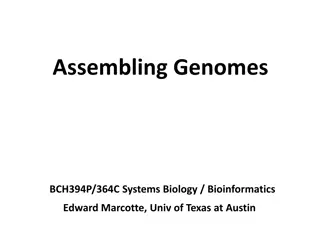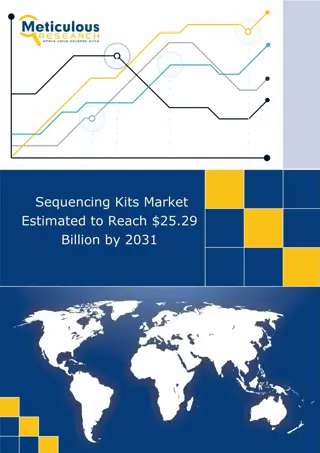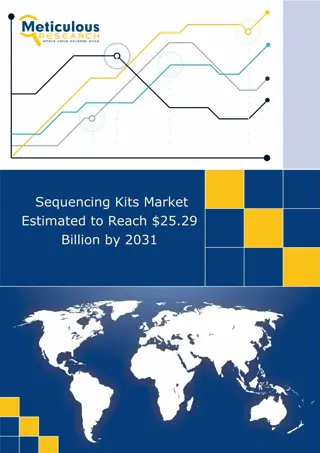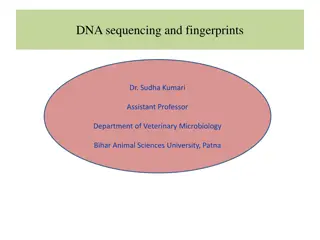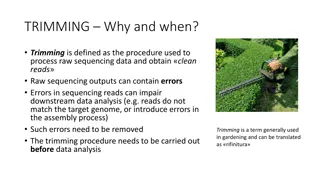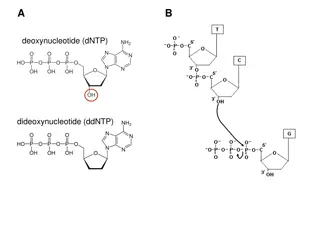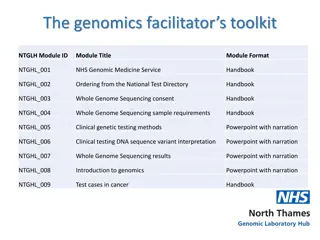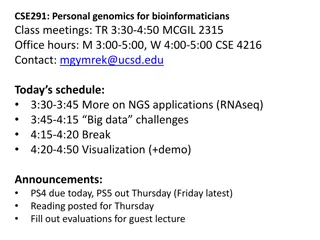
Troubleshooting Sanger Sequencing for Reliable Results
Learn how to troubleshoot Sanger sequencing for optimal results. Explore the common issues such as unreliable data at the beginning and end of sequences, failed reactions, and the importance of DNA purity and concentration. Discover tips for designing primers and interpreting sequencing data effectively.
Download Presentation

Please find below an Image/Link to download the presentation.
The content on the website is provided AS IS for your information and personal use only. It may not be sold, licensed, or shared on other websites without obtaining consent from the author. If you encounter any issues during the download, it is possible that the publisher has removed the file from their server.
You are allowed to download the files provided on this website for personal or commercial use, subject to the condition that they are used lawfully. All files are the property of their respective owners.
The content on the website is provided AS IS for your information and personal use only. It may not be sold, licensed, or shared on other websites without obtaining consent from the author.
E N D
Presentation Transcript
Sanger Sequencing Troubleshooting OSUCCC Genomics Shared Resource Christine Daugherty, MS Laboratory Services Coordinator
Good Sequencing Data Good Sequencing Data The least reliable data is at the beginning and end of the sequence even for well-prepared samples. This is normal and a limitation of the technology.
Beginning of the sequence Beginning of the sequence Peaks are rounded and not well resolved. Note: The sequence of the primer is not in the data because the primer is not labelled. The nucleotides that are extended from the primer are labeled. G black A-green T-red C blue Because the data at the beginning is not reliable, make sure to design your primer ~40-50 bp upstream of your sequence of interest.
Middle of the sequence Middle of the sequence Sharp, well-defined peaks with even spacing between them. Variation in peak heights is normal. Little to no background.
End of the sequence End of the sequence Resolution begins to deteriorate. Peaks become broader, especially when there is more than one of the same nucleotides in a row. Software has difficulty making accurate base calls wide peaks may be called as multiple nucleotides instead of just one.
Failed Reaction Failed Reaction A completely failed sequencing reaction can be very difficult to diagnose as there may be multiple factors causing the problem. Because the sequencing analysis software may still attempt to base call background noise, it s extremely important to always look at your chromatograms and not rely solely on the text file of the sequence. Free chromatogram viewers include Chromas and Thermo Fisher s Sanger Quality Check App.
The two most common causes for sequencing The two most common causes for sequencing failure or poor quality data are: failure or poor quality data are: DNA Purity and Concentration DNA Purity and Concentration
DNA Purity and Quality DNA Purity and Quality Important for both quality data and to avoid damage to the DNA sequencer.
Common Contaminants Common Contaminants: Salts (EDTA, NaCl, NaOAc) Do NOT submit your sample in TE buffer because EDTA chelates the magnesium required by the DNA Polymerase. High levels of salts may also cause current instabilities which damage the capillary array. Proteins, detergents (SDS, Triton X), organic chemicals (ethanol, chloroform, phenol), RNA Note: Submit samples in water.
DNA Purity and Quality DNA Purity and Quality Tips: Avoid excessive freeze-thawing, exposure to UV light, etc. that DNA could degrade the DNA. Some bacterial strains are better than others for template preparation. Some strains are known to release large amounts of endonucleases, inhibitory factors, etc. during lysis that may be difficult to remove. Don t overload your plasmid prep kits as many impurities can be left behind. Do not aggressively vortex during plasmid preps to avoid nicking the DNA.
DNA Concentration DNA Concentration Both low template concentration and high template concentration cause problems. Low Concentration Results have low signal intensity. Analysis software has difficulty in resolving the base peaks from background noise. High Concentration May cause electrophoresis issues by blocking the capillary and inhibiting the current, causing the sequencing reaction to move through the capillary abnormally. Too much template can also deplete the dNTPs early in the sequencing reaction, leading to a premature termination of the reaction.
Other Considerations Other Considerations Design your primer to function at the annealing temperature (60 C) that we use in the core. Because of the volume of samples we process we must use consensus cycling conditions for everyone. Double check your calculations to insure you are submitting the correct amount of template and primer. Do not use genomic DNA as a template. First amplify the region of interest using PCR. Sequence directly from the PCR product or by cloning it into a plasmid.
My sample worked fine before but this time it failed. My sample worked fine before but this time it failed. Your sample may have a weak signal. A weak sample may often work or fail when repeated. This is because there is bleed through of signal from adjacent capillaries. If your sample is in a capillary adjacent to a sample with a high signal, that sample s signal will overpower the signal coming from your weak sample, making it appear as if it failed. If your weak sample was run adjacent to a blank capillary it will appear to work albeit with low signal. The signal from a neighboring capillary may be so strong that the sequence from that sample shows up in your data, making you think that the core has made a mistake in processing your samples.
Troubleshooting Sequencing Data Troubleshooting Sequencing Data Dye Blobs Spikes Homopolymeric Regions Hard Stops (Truncated Sequences) Mixed Peaks Primer Dimers Primer N-1
Dye Blobs Dye Blobs Unincorporated dye terminator molecules (ddNTPs) that were not removed during the cleanup reaction They migrate around 60-90 bp & 90-115 bp They are most often seen with samples of low signal strength
Causes of Dye Blobs Causes of Dye Blobs Problem occurred during the sequencing clean up protocol. Suboptimal sequencing reaction results in poor incorporation of ddNTPs, leading to an excess of unincorporated ddNTPs that can t be removed by the clean up protocol. Contaminates in the sample inhibited the sequencing reaction Too little starting template means less overall proportion of ddNTPs are incorporated
Solutions for Dye Blobs Solutions for Dye Blobs Optimize the sequencing reaction make sure correct amounts of template and primer are used. Make sure template and primers are pure. Sequence from the reverse direction to obtain the sequence obscured by the dye blob. Design a primer further upstream so that the region of interest is no longer obscured by the dye blob.
Spikes Spikes Large peaks of all 4 colors at the same position that obscure the data.
Spikes Spikes Causes of Spikes Small air bubbles, dust, or polymer crystals moving in the capillary through the path of the laser beam causing the laser light to refract onto the CCD camera. Solution for Spikes Re-run sample
Homopolymeric Homopolymeric Regions Regions A long mononucleotide stretch (most often A or T). Data before this encounter is good. Data after the homopolymeric region shows double peaks and a wave-like pattern.
What Causes What Causes Homopolymeric Homopolymeric Regions? Regions? During the sequencing reaction the growing strand may dissociate and reanneal at an incorrect location in the homopolymeric region of the template. This results in the production of multiple products with varying lengths.
Solutions for Solutions for Homopolymeric Homopolymeric Regions Regions Try sequencing in the opposite direction. It may help to design and use a primer which hybridizes close to the repeat region. For poly A regions, use an oligo dT (12-15) primer containing C, A or G on the 3 end as an anchor.
Hard Stops (Truncated Sequences) Hard Stops (Truncated Sequences) Sequence starts out good but the signal strength suddenly stops or decreases.
Cause of Hard Stops Cause of Hard Stops The DNA polymerase has difficulty moving through particular sequences Regions with a high percentage of G s and/or C s Hairpins and secondary structures
Solutions for Hard Stops Solutions for Hard Stops The addition of a denaturant such as betaine or DMSO to the sequencing reaction may help. Try sequencing the complementary strand. Use a primer that binds close to the hairpin. dGTP BigDye Terminator Cycle Sequencing Kit not offered by the GSR due to cost ($1316/100 reactions)
Mixed Peaks Mixed Peaks Peaks that are superimposed on each other.
Causes of Mixed Peaks Corresponding Solutions Purify PCR reactions before submitting for sequencing. (Because two primers are used in a PCR reaction, if excess primers are not removed before sequencing, both primers will act as sequencing primers.) Check template for multiple priming sites. If more than one site is present, design a different primer. Make sure the primer doesn t bind in a repeat region on the template. More than one primer was present in the sequencing reaction The primer is binding to multiple sites in the template
Causes of Mixed Peaks More than one template is present Corresponding Solutions PCR products: Visualize the PCR products on a gel to determine if more than one band is present. If so, gel purify the product of interest. Keep in mind, however, that products with similar sizes may not resolve well on the gel and appear as a single band. In this case you may need to optimize your PCR reaction and/or use different primers.
Causes of Mixed Peaks Corresponding Solutions Plasmid Preps: The plasmid prep contains more than one product (is mixed), for example: 1. The plasmid with the insert and the plasmid without the insert, 2. A mixture of same plasmid, but different inserts. This shows up on the chromatogram as good sequence (from the common plasmid sequence), followed by double overlapping peaks at the start of the cloning site. Note also, that during growth, spontaneous deletions or insertions may occur, giving rise to unexpected sequencing results. Carefully pick single colonies from your plate. Perform a restriction digest and run on an agarose gel to confirm that vector and insert are present as expected.
Primer Dimers Primer Dimers Mixed signal at the beginning, followed by clean sequence. Solution: Redesign the primer
Primer N Primer N- -1 1 Multiple peaks at all positions. The smaller peaks are the true sequence shifted by one or two positions.
Primer N Primer N- -1 1 Cause Caused by poor quality synthesis of the primers which leads to a mixture of full length primers and primers missing one or two bases on the 5 end. Solution Resynthesize the primer
When Submitting Samples When Submitting Samples DOs Label your tubes with consecutive # s Indicate on your form the name of your sample name that corresponds with the tube # Submit a filled out printed form with your samples AND upload your form to eRAMP Label your submission with the eRAMP # and your NAME (first and last) DON Ts Don t parafilm or tape your tubes together Makes tubes difficult to separate and ink is removed when we remove parafilm/tape Don t use symbols in your sample names Don t submit more than 16 individual tubes 17+ put in strip tubes or plate Don t use flat bottom plates Use only PCR plates so samples don t evaporate and can be removed from wells easily.

